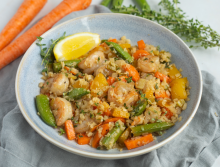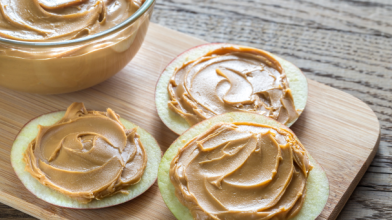
About Thyme
Thyme is an herb from the mint family and a staple ingredient in kitchens around the world—with small, fragrant leaves that are typically green-gray in color. It thrives in sunny and dry conditions and can be grown both outdoors in gardens and indoors in pots.
How to Pick and Store Thyme
When shopping for thyme, look for fresh, vibrant sprigs with intact leaves and a strong smell. To maximize thyme's shelf life, wrap fresh sprigs in a damp paper towel and store them in a plastic bag in the refrigerator. This helps maintain the herb's moisture and aroma for up to a week.
Alternatively, you can dry thyme by hanging it in a well-ventilated area. Once dried, store it in an airtight container away from direct sunlight, where it can retain its flavor and fragrance for several months. You can also find dried thyme in spice aisles, which is a convenient option for year-round use.
The Nutritional Benefits of Thyme
Since it is typically used in small amounts to garnish and add flavor to dishes, thyme can contribute small amounts of certain essential nutrients like vitamin C, vitamin A, potassium, and magnesium to your eating plan.
Thyme contains several antioxidants, including thymol and rosmarinic acid. These compounds have been shown to have anti-inflammatory and antimicrobial properties.
How to Use Thyme in Your Cooking
Thyme offers a pleasant, slightly sweet, earthy taste with subtle hints of mint and lemon that enhances the flavor of dishes. It pairs well with various meats, including poultry, beef, lamb, and fish. Sprinkle some fresh or dried thyme leaves over roasted vegetables or incorporate them into marinades, soups, stews, and sauces for a delightful aromatic touch. A serving of thyme is two tablespoons when fresh or one teaspoon when dried.
Thyme also pairs well with other herbs such as rosemary, oregano, and parsley. Mix and match these herbs to boost the flavor of your dishes. Whether you're preparing a hearty roast, a fragrant soup, or a light salad, thyme can be your trusted companion in the kitchen to add depth and aroma to your dishes.
Diabetes-friendly recipes featuring thyme:

Sautéed Thyme Mushrooms
Bursting with flavor and seasoned to perfection, these mushrooms are a tasty addition to any meal.

Lemon Thyme Shrimp Stir Fry with Cauliflower Rice
This tasty Lemon Thyme Shrimp Stir-Fry uses diabetes-friendly ingredients like cauliflower rice and fresh herbs to ensure your dinner won’t spike your blood glucose (blood sugar) levels.

Roasted Pork Tenderloin with Thyme and Balsamic Roasted Grapes
Infused with aromatic thyme and garlic marinade, the tender pork is a flavor-packed masterpiece.














